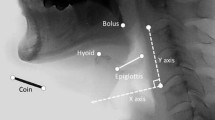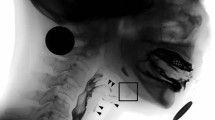Abstract
Reduced maximal hyoid excursion has been suspected as one of the primary physiologic causes of aspiration after a stroke. Vertical and anterior displacement of hyoid excursion is critical to epiglottic closure for airway protection and the opening of the upper esophageal sphincter (UES). Without these carefully timed and well-executed components, the bolus cannot pass safely through the pharynx. The purpose of this study was to evaluate vertical and anterior displacement of the hyoid bone during oropharyngeal swallowing in two groups of subjects: (1) 16 stroke patients who aspirate before or during the swallow (aspirators), and (2) 33 stroke patients who do not aspirate (nonaspirators). Means and standard deviations for anterior and vertical displacement were analyzed for 5- and 10-ml thin-liquid boluses using the ImageJ program (136 swallows). A two-way analysis of variance (ANOVA) was run with group and volume as independent variables. There was no significant difference between the two groups for vertical or anterior displacement. Maximal anterior displacement of the hyoid bone was slightly longer in nonaspirators than in aspirators. Aspiration before and during the swallow may be related more to the triggering of pharyngeal swallow than to the maximal extent of hyoid excursion.



Similar content being viewed by others
References
Groher ME. The detection of aspiration and videofluoroscopy. Dysphagia. 1994;9:147–8. doi:10.1007/BF00341257.
Holas MA, DePippo KL, Reding MJ. Aspiration and relative risk of medical complications following stroke. Arch Neurol. 1994;51(10):1051–3.
Cook IJ, Dodds WJ, Dantas RO, Kern MK, Massey BT, Shaker R, et al. Timing of videofluoroscopic, manometric events, and bolus transit timing during the oral and pharyngeal phases of swallowing. Dysphagia. 1989;4:8–15. doi:10.1007/BF02407397.
Jacob P, Kahrilas PJ, Logemann JA, Shah V, Ha T. Upper esophageal sphincter opening and modulation during swallowing. Gastroenterology. 1989;97(6):1469–78.
Kendall KA, Leonard RJ. Hyoid movement during swallowing in older patients with dysphagia. Arch Otolaryngol Head Neck Surg. 2001;127(10):1224–9.
Perlman AL, Grayhack JP, Booth BM. The relationship of vallecular residue to oral involvement, reduced hyoid elevation, and epiglottic function. J Speech Hear Res. 1992;35:734–41.
Perlman AL, Booth BM, Grayhack JP. Videofluoroscopic predictors of aspiration in patients with oropharyngeal dysphagia. Dysphagia. 1994;9(2):90–5. doi:10.1007/BF00714593.
Perlman AL, VanDaele DJ, Otterbacher MS. Quantitative assessment of hyoid bone displacement from video images during swallowing. J Speech Lang Hear Res. 1995;38(3):579–85.
Ishida R, Palmer JB, Hiiemae KM. Hyoid motion during swallowing: factors affecting forward and upward displacement. Dysphagia. 2002;17(4):262–72. 10.1007/s00455-002-0064-5.
Dodds WJ, Man KM, Cook IJ, Kahrilas PJ, Stewart ET, Kern MK. Influence of bolus volume on swallow-induced hyoid movement in normal subjects. AJR Am J Roentgenol. 1988;150(6):1307–9.
Cook IJ, Dodds WJ, Dantas RO, Massey BT, Kern MK, Lang IM, et al. Opening mechanisms of the human upper esophageal sphincter. Am J Physiol. 1989;257(20):G748–59.
Kim Y, McCullough G. Maximum hyoid displacement in normal swallowing. Dysphagia. 2008;23:274–9. doi:10.1007/s00455-007-9135-y.
Logemann JA, Pauloski BR, Rademaker AW, Colangelo LA, Kahrilas PJ, Smith CH. Temporal and biomechanical characteristics of oropharyngeal swallow in younger and older men. J Speech Lang Hear Res. 2000;43(5):1264–74.
Logemann JA, Pauloski BR, Rademaker AW, Kahrilas PJ. Oropharyngeal swallow in younger and older women: videofluoroscopic analysis. J Speech Lang Hear Res. 2002;45(3):434–45. 10.1044/1092-4388(2002/034).
Kim Y, McCullough GH, Asp CW. Stage transition duration in patients post-stroke. Dysphagia. 2007;22:299–305. doi:10.1007/s00455-007-9085-4.
McCullough GH, Wertz RT, Rosenbek JC. Severity and specificity of clinical/bedside examination signs for detecting aspiration in adults subsequent to stroke. J Commun Disord. 2001;34:55–72. doi:10.1016/S0021-9924(00)00041-1.
Rasband W. Imag J 1.32j. National Institutes of Health. 2004. http://rsb.info.nih.gov/ij. Accessed 15 April 2005.
Pauloski BR, Logemann JA, Fox JC, Colangelo LA. Biomechanical analysis of the pharyngeal swallow in postsurgical patients with anterior tongue and floor of mouth resection and distal flap reconstruction. J Speech Lang Hear Res. 1995;38:110–23.
Robbins JA, Levine RL. Swallowing after unilateral stroke of the cerebral cortex: preliminary experience. Dysphagia. 1998;3:11–7. doi:10.1007/BF02406275.
Acknowledgments
This work has been made possible in part by a Scholarly Activity Award from the College of Health and Human Services, Ohio University.
Author information
Authors and Affiliations
Corresponding author
Rights and permissions
About this article
Cite this article
Kim, Y., McCullough, G.H. Maximal Hyoid Excursion in Poststroke Patients. Dysphagia 25, 20–25 (2010). https://doi.org/10.1007/s00455-009-9224-1
Received:
Accepted:
Published:
Issue Date:
DOI: https://doi.org/10.1007/s00455-009-9224-1




